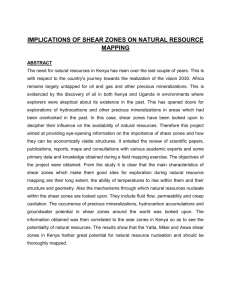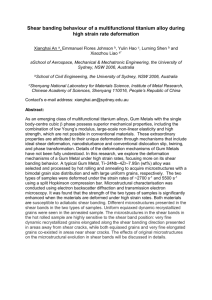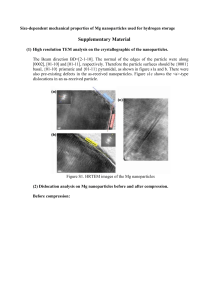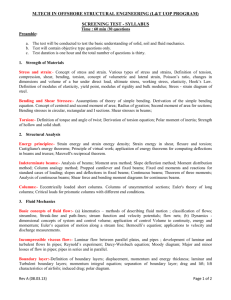clicking here
advertisement
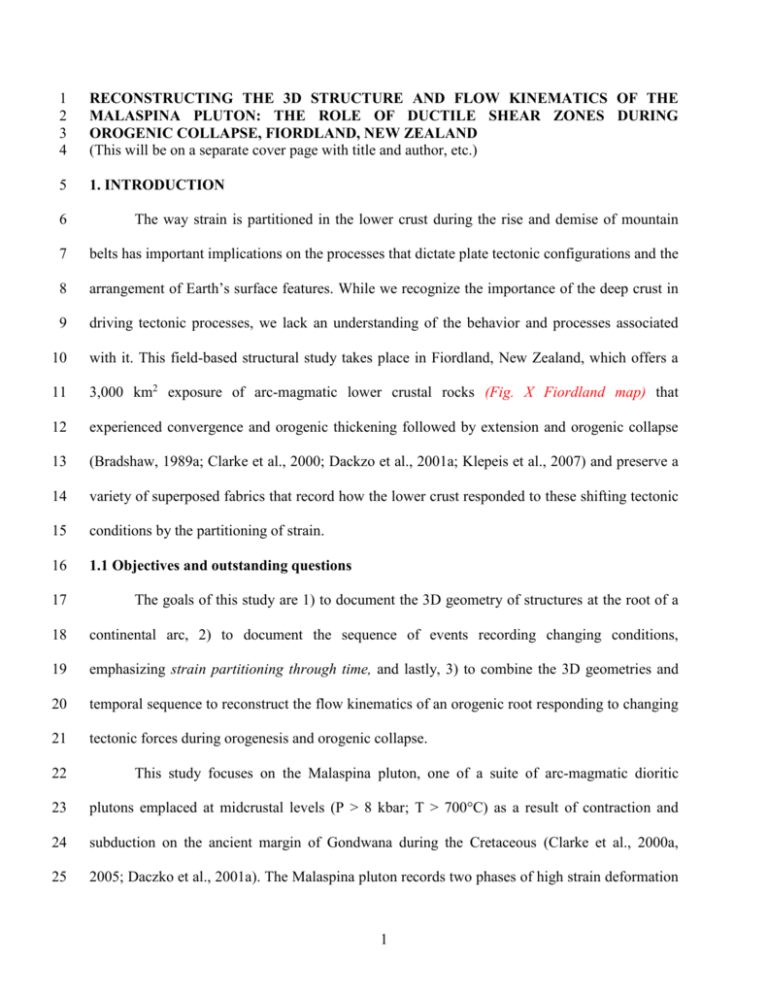
1 2 3 4 RECONSTRUCTING THE 3D STRUCTURE AND FLOW KINEMATICS OF THE MALASPINA PLUTON: THE ROLE OF DUCTILE SHEAR ZONES DURING OROGENIC COLLAPSE, FIORDLAND, NEW ZEALAND (This will be on a separate cover page with title and author, etc.) 5 1. INTRODUCTION 6 The way strain is partitioned in the lower crust during the rise and demise of mountain 7 belts has important implications on the processes that dictate plate tectonic configurations and the 8 arrangement of Earth’s surface features. While we recognize the importance of the deep crust in 9 driving tectonic processes, we lack an understanding of the behavior and processes associated 10 with it. This field-based structural study takes place in Fiordland, New Zealand, which offers a 11 3,000 km2 exposure of arc-magmatic lower crustal rocks (Fig. X Fiordland map) that 12 experienced convergence and orogenic thickening followed by extension and orogenic collapse 13 (Bradshaw, 1989a; Clarke et al., 2000; Dackzo et al., 2001a; Klepeis et al., 2007) and preserve a 14 variety of superposed fabrics that record how the lower crust responded to these shifting tectonic 15 conditions by the partitioning of strain. 16 1.1 Objectives and outstanding questions 17 The goals of this study are 1) to document the 3D geometry of structures at the root of a 18 continental arc, 2) to document the sequence of events recording changing conditions, 19 emphasizing strain partitioning through time, and lastly, 3) to combine the 3D geometries and 20 temporal sequence to reconstruct the flow kinematics of an orogenic root responding to changing 21 tectonic forces during orogenesis and orogenic collapse. 22 This study focuses on the Malaspina pluton, one of a suite of arc-magmatic dioritic 23 plutons emplaced at midcrustal levels (P > 8 kbar; T > 700°C) as a result of contraction and 24 subduction on the ancient margin of Gondwana during the Cretaceous (Clarke et al., 2000a, 25 2005; Daczko et al., 2001a). The Malaspina pluton records two phases of high strain deformation 1 26 and metamorphism displaying contrasting styles of strain partitioning after its emplacement at 27 116 ± 2 Ma (U-Pb zircon dating, Tulloch and Kimbrough, 2003; Hollis et al., 2004). The first 28 phase involved the burial and partial recrystallization of the pluton at ca. 40 km depth at the high- 29 P (P = 11–16 kbar and T > 750°C) granulite facies (Daczko et al., 2001a; Allibone et al., 2009b), 30 which produced broad (affecting >200 km2) high strain zones marked by high-T recrystallization 31 and episodic partial melting (cite Schwartz 2013 abstract). The second phase involved the 32 transition from regional contraction to ductile extension and orogenic collapse by ca. 114 Ma 33 (Klepeis et al., 2007), which produced sets of localized (affecting ~80 km2) upper-amphibolite 34 facies (give pressures and temps here) shear zones marked by cooling, hydration, and 35 retrogression (cite Schwartz 2013 abstract). 36 The precise role of the high-strain upper-amphibolite shear zones in the collapse of the 37 over-thickened orogen is debated. Traditionally, they were believed to function as a major 38 detachment that decoupled the lower crust from the upper crust and allowed for the thinning and 39 exhumation of the lower crust (Oliver, 1980; Gibson and Ireland, 1988; Klepeis and King, 2009); 40 an interpretation fitting with the metamorphic core complex model (Gibson et al., 1988; Gibson 41 and Ireland, 1995; Hill, 1995a,b; Turnbull, 2010). More recent work (e.g. Allibone et al., 2009b; 42 Clarke et al., 2010) challenges this interpretation by pointing out that many of the contacts 43 between the basement and cover sequence are pristine, meaning there could not have been 44 significant offset on the shear zones – something that the core complex model necessitates. These 45 findings suggest that the high-strain shear zones may have functioned within a network of many 46 smaller interconnected shear zones each accommodating a small amount of displacement rather 47 than a single decollement in a metamorphic-core-complex-style system (Allibone et al., 2009). 48 Thus, figuring out the changing styles of strain partitioning is germane to resolving what 2 49 processes were responsible for achieving orogenic collapse and for drastically altering the 50 appearance of this part of the world. 51 52 53 2. SUMMARY OF WORK COMPLETED 54 Field data collection, including sampling and measuring the orientations of foliations, 55 lineations, fault planes, and other structures, is complete and all field data are compiled. A sensitivity 56 test of the Rf/ϕ method on assessing strain gradients in the Malaspina has been conducted. Thin 57 section analysis for the purpose of characterizing structures and looking for shear sense indicators is 58 underway but not complete. Structural analysis, including domain analysis and the construction of 59 cross sections through the Malaspina pluton, is well underway. 60 Fabric analysis– Shape preferred orientations of deformed ellipsoidal objects may be used as 61 a proxy for determining the degree of relative distortion within a sample group, and can be assessed 62 using the Rf/ϕ method (Lisle, 1985). Because the applicability of the Rf/ ϕ method has not been 63 tested for diorites, we conducted a sensitivity test to determine whether the method can be 64 applied to reproducibly obtain relative strain of deformed diorites and whether the analysis 65 produced results consistent with strain gradients observed in the field. We selected a suite of 66 eight samples with comparable mineral assemblages and a range in strain intensity as observed 67 on the hand-sample scale and in the field. Three collaborators and I each analyzed the same suite 68 of eight samples and then compared our results, which are discussed under Initial Interpretations. 69 Thin section analysis – I have documented thin section descriptions for ~60% of my 70 samples, including fabric designations (i.e. high vs. low strain and metamorphic assemblage and 3 71 grade), the presence of shear sense indicators. These observations feed into my broader structural 72 analysis and serve as a basis for characterizing different strain fabrics and providing sense of 73 shear, where it is preserved. (Fig. X showing granulite vs. amphibolite examples in thin section) 74 Structural analysis – Using a combination of field notes, hand samples, and thin sections, 75 I have determined designations of high and low strain granulite-facies fabrics and upper- 76 amphibolite-facies fabrics throughout Breaksea Sound, which exposes a ~40 km continuous 77 cross-section though the Malaspina pluton. I have plotted these on an updated study-area map 78 (Fig. X of high strain zones map) and have constructed a cross-section reflecting the distribution 79 and orientations of these fabrics (Fig. X massive cross section). From these we see that the 80 granulite facies fabric is undulatory with variably shallowly to moderately plunging lineations, 81 and two broad high strain populations towards the northeastern and western portions of the 82 pluton. The upper-amphibolite facies shear zone fabric cross-cuts the granulite-facies fabric and 83 is variably shallowly to steeply dipping and localized towards – but not exclusive to – the 84 contacts between the basement and cover sequence. The upper-amphibolite shear fabrics display 85 contrasting geometries, with “lozenge shapes” prevalent within thick (give range of thickness) 86 shear zones (Fig. X show pics of these), and narrower shear zones with tight deflection patterns 87 towards the interior of the Malaspina (Fig. X pics of these examples). Preliminary block diagrams 88 showing the 3D distribution of these contrasting styles of granulite-facies and upper-amphibolite- 89 facies high strain zones have also been drafted (Fig. X show them). 90 3. INITIAL INTERPRETATIONS 91 Fabric analysis – Our sensitivity test revealed that the Rf/ϕ method does replicate the 92 strain gradients observed in the field. However, we are unable to determine the statistical error 93 involved in the analysis due to our limited manpower. Also, because it is not a standalone method 4 94 and must be used in conjunction with both field and thin section observations, for the goals of my 95 study the method is not so powerful in providing answers to how strain is partitioned. 96 Structural analysis – The updated map and cross-section show the highest strain zones 97 (both granulite- and upper-amphibolite-facies) concentrated towards two areas in the Malaspina 98 pluton: one that is coincident with the Doubtful Sound Shear Zone towards the northeast of the 99 pluton and the other with the Resolution Island Shear Zone towards the west of the pluton. In 100 between these areas there is the presence of relatively little strain in the form of small, distributed 101 upper-amphibolite shear zones. This region perhaps represents a kind of ‘accommodation zone’ 102 between the two highest strain regions. The results of mapping also confirm the claims of 103 Allibone et al. (2009) that not all contacts are sheared, which implies much smaller offset on the 104 shear zones than previously believed. In addition, the disappearance of shear zones towards the 105 southern portion of the pluton also puts into questions on how spatially continuous these features 106 are on the regional scale. 107 3.1 Potential implications 108 While the high-strain upper-amphibolite shear zones are generally focused towards the 109 basement-cover contacts, they include multiple populations that are found throughout the pluton. 110 These patterns imply that the core complex model is ill fitted for explaining the pattern of strain 111 partitioning in the Malaspina. Instead, the Malaspina pluton may have been exhumed piece-meal 112 by a combination of distributed ductile shear zones during the Late Cretaceous and later-stage 113 Cenozoic faults (Fig. X show example models of MCC vs. distributed shearing). It is therefore 114 relevant to expand the story past the formation of the upper-amphibolite shear zones and consider 115 what happened after the Late Cretaceous phase of ductile extension: From ca. 114 Ma onwards, 116 extensional collapse continued (Klepeis et al., 2007) and resulted in the opening of the Tasman 117 Sea by 84 Ma (Sutherland, 1999; Mortimer, 2004a; Tulloch et al., 2009b). Brittle and semi-brittle 5 118 faulting throughout southwestern New Zealand accommodated further plate boundary 119 reorganization by late Tertiary times, and led to the development of the modern Australian- 120 Pacific boundary, demarcated in this region by the Alpine Fault (Sutherland, 1995; Dackzo et al., 121 2001a; Klepeis and King, 2009). Thus, late-stage faults were prevalent and influential features 122 that may have played a greater role in assisting extensional collapse than previously recognized. 123 4. CHANGES TO RESEARCH PLAN 124 125 Considering the implications of the initial interpretations above, I plan to make the following changes to this study: 126 1) De-emphasize the analysis of fabric strain intensities using the Rf/ϕ method. 127 2) Expand structural analysis to Doubtful Sound (northeastern Malaspina), Resolution 128 Island (western Malaspina), and Wet Jacket Arm (southern Malaspina) to compare strain 129 gradients across different parts of the pluton and answer the question: what’s the southern extent 130 of the shear zones found within the Malaspina? 131 3) Expand the sequence of events to include late-stage semi-brittle faults to see if these 132 may help explain the mechanism of collapse and exhumation in Fiordland. I plan to combine the 133 fault data from my field area (which has hitherto represented a data gap) with fault data compiled from 134 throughout Fiordland. The objective is to see if fault kinematics match well with upper-amphibolite 135 flow patterns or better with stress orientations consistent with later tectonic configurations. This may 136 tell us how (and allow us to bracket when) the bulk of the rotation/exhumation of this section of crust 137 was achieved in Fiordland. 138 5. WORK REMAINING 6 139 Work remaining for this study include the construction of a cross-section along Wet Jacket 140 Arm to see how shear zones “die out” to the south (these data are already compiled and ready to be 141 used in cross-section construction), the compilation of kinematic indicators for each phase in the 142 sequence of phases of deformation and metamorphism, fault analysis to see what role they played in 143 exhuming the crust (data from my study area are compiled and ready to be analyzed), the synthesis of 144 data into 3D block diagram flow maps showing strain partitioning throughout successive phases of 145 deformation and metamorphism, and finally, the comparison of these flow patterns with features in 146 and outside of Fiordland to confirm our association of these structures with regional contractional and 147 extensional events. Together, these analyses will help to improve our understanding of how the lower 148 crust responds to changing conditions and the consequences of strain partitioning in shaping crustal 149 processes. 150 6. RESEARCH TIMELINE 2013 End of Fall Completed work Dec 5-11 Dec 15 2014 Spring Jan 10 Jan Jan 13-17 Dec Field measurements and samples collected and organized Photographs and notes compiled and digitized Rf/phi analysis for desired samples complete Representative measurements selected and mapped Breaksea Sound 45-km cross-section complete (needs final fine-tuning) ~60% of thin sections analyzed Presented work at GSA Denver, CO Local fault data compiled, ready to be analyzed Wet Jacket Arm data compiled, ready to make cross-section Preliminary block diagrams for D2 and D3 drafted Begin fault analysis Leave for winter break Return from winter break Kinematics week - plot all kinematic indicator locations and results for high strain granulite fabrics and upper-amphibolite shear zones 7 Feb Mar Apr May Jun Jul Aug Jan 20-31 Feb 03 Feb 04-17 Mar 03-07 Mar 10-31 Apr 01-30 May 1-16 May 19-23 May 26-30 Jun 16 Mid-Jul Mid-Aug Fault analysis and write GACMAC abstract GACMAC 2013 abstract due Complete Wet Jacket Arm cross-section Spring Break Flow pattern block diagrams Writing and figures (compile methods and results sections) Writing and figures (background and discussion) GACMAC 2013 New Brunswick Writing and figures (conclusions, editing previous sections) Complete first draft Final draft Defense and final revisions 151 Table 1. Updated research schedule for completion of M.S. project. 152 7. FIGURES 153 In progress, sorry folks. 8

